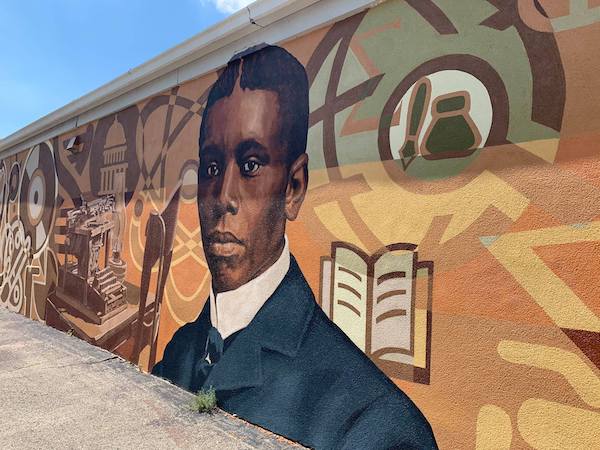President's Blog: From the Heart

A Poet and His Song
By Eric F. Spina
University of Dayton poet Dr. Herbert Woodward Martin and songstress Dr. Minnita Daniel-Cox have performed the works of Paul Laurence Dunbar dozens of times together all over the country, but when they reunite this weekend in Sears Recital Hall, their interpretation will take on greater poetic meaning.
This year marks the sesquicentennial of Dunbar’s birth, and the duo is part of a community-wide effort to shine the light brightly on one of America’s greatest poets and introduce the Dayton native’s legacy to a new generation of students.
It’s just one example of how our faculty are coming together across disciplines to elevate the prolific writer’s work, which includes 12 books of poetry, four novels, four anthologies of short stories, and popular song lyrics — all written during a life that spanned just 33 years.
I cheer the efforts of Minnita and colleagues Dr. Ju Shen and Dr. Jennifer Speed, who have received grants totaling $250,000 from the National Endowment for the Humanities and the Andrew W. Mellon Foundation to promote awareness, appreciation, and scholarly inquiry into the work of the first Black poet to gain national preeminence, a pioneer who paved the way for Langston Hughes and others. For instance, Maya Angelou’s autobiography I Know Why the Caged Bird Sings took its name from Dunbar’s poem, “Sympathy,” which is part of an exhibit of archival Dunbar photos, books, and correspondence being displayed through March 4 in the Stuart and Mimi Rose Gallery in Roesch Library.
I don’t have to look far across campus to see — and appreciate — the fruits of our faculty’s collaboration:
- To jumpstart the initiative in 2014, Minnita created a Dunbar Music Archive, an online, searchable database of music with texts by Dunbar, which now includes a dialect glossary. She’s hired nearly a dozen student research assistants who are transcribing more than 360 handwritten letters and creating a searchable database as part of a larger digital archive of Dunbar’s work that will be freely available to scholars. As part of Dayton’s ambitious Dunbar 150 project, the Paul Laurence Dunbar House was transformed on the poet’s birthday last summer into a living museum that included musical performances by UD students.
- English majors in Dr. David Fine’s “Foundations of Textural Analysis and Research” class are analyzing Dunbar’s work in the context of their own scholarly interests, whether literary studies, rhetoric, writing, or teaching. Last year, his students created high school lesson plans.
- Dr. Vanessa Winn has integrated the life and work of Dunbar in her social studies methods course for aspiring teachers.
- Dr. R. Darden Bradshaw’s art education students are visiting Dayton’s historic Paul Laurence Dunbar House, reading scholarly work from Dunbar experts, and connecting the writer’s work to art and social justice themes that will be integrated into lesson plans for K-8 students. In the fall, among other projects, students in her “Integrating Visual Culture” class took photos on their cell phones of artifacts in the Dunbar House, and after selecting one of his poems, drew artistic interpretations. After listening to “Racism in Dayton Dialogues,” they interspersed their own voice in these drawings
These are just a few of the growing number of engaging projects by the 2021 Dunbar Faculty Development Cohort and the Dunbar Initiative’s coordinators.
I think it’s fitting that our very own Professor Emeritus Herbert Woodward Martin has a part in the sesquicentennial celebration. In 1972, he organized the centennial celebration that brought poets Margaret Walker and Nikki Giovanni to campus. Over his career, he earned acclaim for dressing up like Dunbar in a vintage morning coat and striped pants and “borrowing” his voice to entertain audiences nationwide with recitations of Dunbar’s dialect-rich poetry.
“I really am happy that the community and the nation have taken stock of him,” says the 89-year-old poet and Dunbar scholar. “It’s gratifying.”
Minnita agrees: “Dunbar changes the game. He’s seminal in handing off the baton.”
(“A Dunbar Celebration” will take place at 2:30 p.m. on Saturday, Feb. 12 at Woodland Cemetery and Mausoleum, where the UD Chorale, under the direction of Steven Hankle, will perform a selection of Dunbar-themed music. The celebration includes remarks by LaVerne Sci, Dayton historian, and a foreword in the program by Tom Morgan, UD’s resident Dunbar scholar. As part of the program, Herbert Woodward Martin and Minnita Daniel-Cox will present “I Know Why the Caged Bird Sings” at 3:15 p.m. in Sears Recital Hall. The events, free and open to the public, are co-sponsored by UD’s Department of Music and the Dayton Aviation Heritage National Historical Park.)
